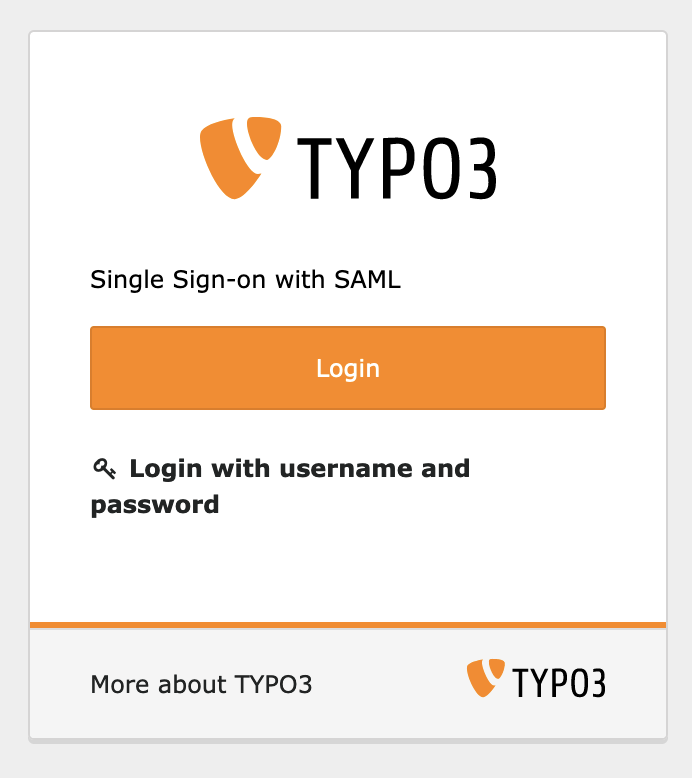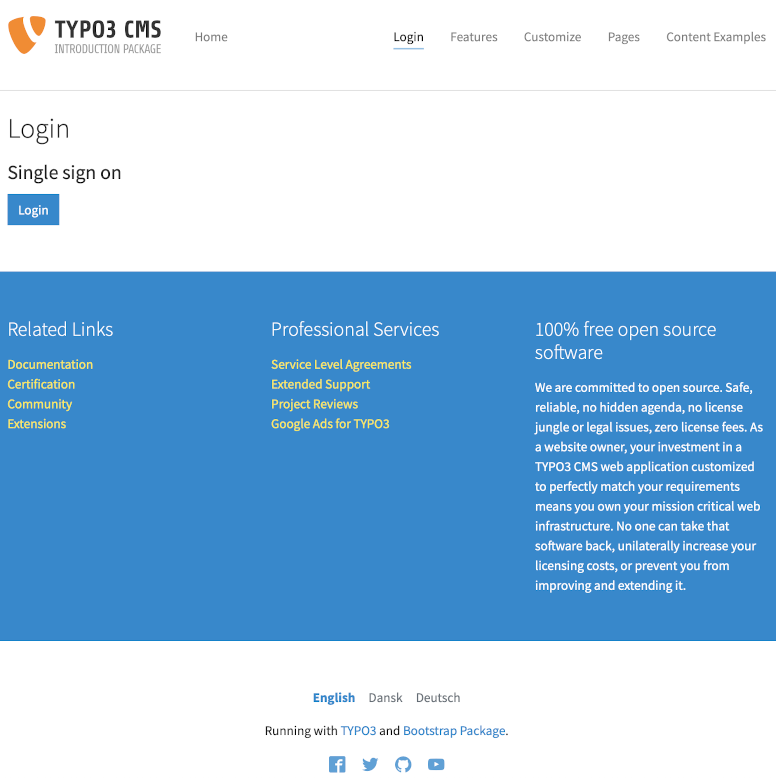mediadreams / md_saml
SSO frontend or backend login with SAML authentication.
Installs: 14 971
Dependents: 0
Suggesters: 0
Security: 0
Stars: 7
Watchers: 5
Forks: 11
Open Issues: 9
Type:typo3-cms-extension
Requires
- php: >=8.2
- onelogin/php-saml: ^4.0
- typo3/cms-backend: ^13.4
- typo3/cms-core: ^13.4
Requires (Dev)
- ergebnis/composer-normalize: ^2.28.3
- friendsofphp/php-cs-fixer: ^3.48.0
- phpstan/extension-installer: ^1.3.1
- phpstan/phpstan: ^1.10.56
- phpstan/phpstan-strict-rules: ^1.5.2
- rector/rector: ^1.2
- saschaegerer/phpstan-typo3: ^1.9.1
- squizlabs/php_codesniffer: ^3.8.1
- ssch/typo3-rector: ^2.6
- tomasvotruba/type-coverage: ^0.2.1
- typo3/cms-fluid: ^12.4
- typo3/coding-standards: ^0.6.1
README
Single Sign-on extension for TYPO3. It enables you, to log into the TYPO3 backend or the website frontend by using an Identity Provider (IdP), for example an ADFS server (Active Directory Federation Services). It is fully configurable by TypoScript.
Screenshots
TYPO3 login:
Frontend login:
Requirements
- TYPO3 v13.4
Installation
- Install the extension with the following composer command:
composer req mediadreams/md_samlor use the extension manager - In module
Site ConfigurationaddMdSaml base configuration (ext:md_saml)in sectionSets for this Site - Activate backend login in the extension configuration. Frontend login is activated in the settings of the extension.
- Configure the extension by overriding the site settings of the extension
Configuration
Site Set
The Service Provider (SP) and Identity Provider (IdP) can be configured by adding the settings in the Site Set
MdSaml base configuration (ext:md_saml), which is shipped with this extension.
Include the Site Set MdSaml base configuration (ext:md_saml) in the Site Configuration
of your website.
Now modify the settings according to your needs. In order to get your custom configuration in place, add a Site Set in your site package as shown below:
The following example shows, how to modify the default configuration of ext:md_saml:
EXT:my_extension/Configuration/Sets/MdSamlOverrides/config.yaml:
name: my_extension/md_saml
label: MdSaml config for my website
dependencies:
- mediadreams/md_saml
EXT:my_extension/Configuration/Sets/MdSamlOverrides/settings.yaml:
md_saml:
mdsamlSpBaseUrl: 'https://%env(BASE_DOMAIN)%'
be_users:
databaseDefaults:
usergroup: 3
lang: 'de'
fe_users:
saml:
sp:
entityId: '/login/?loginProvider=1648123062&mdsamlmetadata'
assertionConsumerService:
url: '/login/?loginProvider=1648123062&login-provider=md_saml&login_status=login&acs&logintype=login'
saml:
sp:
x509cert: '%env(SAML_SP_X509CERT)%'
privateKey: '%env(SAML_SP_PRIVATE_KEY)%'
idp:
entityId: 'https://auth.myprovider.de/adfs/services/trust'
singleSignOnService:
url: 'https://auth.myprovider.de/adfs/ls/'
singleLogoutService:
url: 'https://auth.myprovider.de/adfs/ls/'
x509cert: '%env(SAML_IDP_X509CERT)%'
As you can see, you can use environment variables in your configuration in order to configure different setups.
ATTENTION
Somehow, it is not possible to use environment variables in site sets at the moment. So if you want to use env vars, do it in the general site configuration in <project-root>/config/sites/<identifier>/config.yaml. Add following at the bottom of the config file:
settings:
md_saml:
mdsamlSpBaseUrl: '%env(SAML_BASE_DOMAIN)%'
General information on site sets can be found here.
SAML
- Set a base url in
md_saml.mdsamlSpBaseUrlfor all endpoints - Generate a certificate for the Service Provider (SP)
openssl req -newkey rsa:3072 -new -x509 -days 3652 -nodes -out sp.crt -keyout sp.key - Open certificate files and remove all line breaks. Copy value of
sp.crttomd_saml.saml.sp.x509certand value ofsp.keytomd_saml.saml.sp.privateKey
Backend
Activate backend login in the extension configuration. Go to
Settings -> Extension Configuration -> md_saml and check/uncheck the checkbox.
md_saml.be_users.saml.sp.entityId
Identifier of the backend (TYPO3) SP entity (must be a URI)
ATTENTION:mdsamlSpBaseUrlwill be attached automatically
Default:/typo3/index.php?loginProvider=1648123062&mdsamlmetadatamd_saml.be_users.saml.sp.assertionConsumerService.url
Specifies info about where and how the message of a backend (TYPO3) login MUST be returned to the requester, in this case our SP.
Default:/typo3/index.php?loginProvider=1648123062&login-provider=md_saml&login_status=login&acs
Frontend
Activate frontend login by setting the constant md_saml.fe_users.active = 1.
By default it is enabled and it will load a different login template.
md_saml.fe_users.saml.sp.entityId
Identifier of the frontend SP entity (must be a URI)
ATTENTION:mdsamlSpBaseUrlwill be attached automatically
Example (just replace the speaking path ("/login/") according to your needs):/login/?loginProvider=1648123062&mdsamlmetadatamd_saml..fe_users.saml.sp.assertionConsumerService.url
Specifies info about where and how the message of a frontend login MUST be returned to the requester, in this case our SP.
Example (just replace the speaking path ("/login/") according to your needs):/login/?loginProvider=1648123062&login-provider=md_saml&login_status=login&acs&logintype=login
Note
All default settings, which are configured in md_saml.saml can be overwritten for backend or
frontend needs with properties in md_saml.be_users.saml... (backend) and
md_saml.fe_users.saml... (frontend).
As underlying SAML toolkit the library of OneLogin is used (no account with OneLogin is needed!). See full documentation for details on the configuration.
Users
You are able to create new users, if they are not present at the time of login.
- Backend
md_saml.be_users.createIfNotExist...
Default = 1, so be_users will be created, if they do not exist. - Frontend
md_saml.fe_users.createIfNotExist...
Default = 1, so fe_users will be created, if they do not exist.
You are able to update existing users, if they are already present at the time of login.
- Backend
md_saml.be_users.updateIfExist...
Default = 1, so be_users will be updated, if they exist. - Frontend
md_saml.fe_users.updateIfExist...
Default = 1, so fe_users will be updated, if they exist.
Backend
md_saml.be_users.createIfNotExist
Decide whether a new backend user should be created (Default = 1)md_saml.be_users.updateIfExist
Decide whether a backend user should be updated (Default = 1)md_saml.be_users.databaseDefaults...
This section allows you to set defaults for a newly created backend user. You can add any fields of the database here.
Example:md_saml.be_users.databaseDefaults.usergroup = 123will create a new user with usergroup 123 attached.
Frontend
md_saml.fe_users.createIfNotExist
Decide whether a new frontend user should be created (Default = 1)md_saml.fe_users.updateIfExist
Decide whether a frontend user should be updated (Default = 1)md_saml.fe_users.databaseDefaults...
This section allows you to set defaults for a newly created frontend user. You can add any fields of the database here.
Example:md_saml.fe_users.databaseDefaults.usergroup = 123will create a new user with usergroup 123 attached.
ATTENTION:md_saml.fe_users.databaseDefaults.pidwill be used as storage for newsly created fe_users.
SSO
The returned value of the SSO provider can be anything. With the following configuration set the names of the returned values to the ones needed in TYPO3:
Backend
md_saml.be_users.transformationArr
Example:md_saml.be_users.transformationArr.username = http://schemas.microsoft.com/ws/2008/06/identity/claims/windowsaccountname
The above example shows the returning value of an ADFS server, which contains the username for TYPO3.
Frontend
md_saml.fe_users.transformationArr
Example:md_saml.fe_users.transformationArr.username = http://schemas.microsoft.com/ws/2008/06/identity/claims/windowsaccountname
The above example shows the returning value of an ADFS server, which contains the username for a frontend user.
ADFS
The following steps are an example on how to configure an ADFS server as IdP (Identity Provider).
Since I don't have the configuration in english, the following section is available in german only. I am sorry for that!
-
Get SP (Service Provider) meta data. Log into TYPO3 (important!) and call
/typo3/index.php?loginProvider=1648123062&mdsamlmetadata&loginType=backendfor the backend configuration and/typo3/index.php?loginProvider=1648123062&mdsamlmetadata&loginType=frontendfor the frontend configuration. -
Neue
Vertrauensstellung der vertrauenden Seiteerstellen-
Willkommen
- Modus
Ansprüche unterstützenauswählen - Knopf
Startklicken
- Modus
-
Datenquelle auswählen
- Option
Daten über vertrauende Seite aus einer Datei importierenauswählen - XML der Metadaten aus dem ersten Schritt auswählen
- Knopf
Weiterklicken
- Option
-
Anzeigennamen angeben
- Einen Wert für
Anzeige Nameeintragen Weiterklicken
- Einen Wert für
-
Zugriffssteuerungsrichtline auswählen
- Im Feld
Wählen Sie eine Zugriffssteuerungsrichtlinie aus, denZugriff-OTPauswählen Weiterklicken
- Im Feld
-
Bereit zum Hinzufügen der Vertrauensstellung
- Daten prüfen und
Weiterklicken
- Daten prüfen und
-
Fertig stellen
Schließenklicken
-
-
Die
Ansprucheaustellungsrichtlinie für diese Anwendung konfigurierenprüfen -
Neue Regel mit
Regel hinzufügen ...hinzufügen -
Im Feld
Anspruchsregelvorlagedie OptionAnsprüche mithilfe einer benutzerdefinierten Regel sendenauswählen undWeiterklicken -
Im Feld
Anspruchsregelnameden WertName Identifiereingeben -
Im Feld
Benutzerdefinierte Regelfolgendes eingeben:
c:[Type == "http://schemas.microsoft.com/ws/2008/06/identity/claims/windowsaccountname"] => issue(Type = "http://schemas.xmlsoap.org/ws/2005/05/identity/claims/nameidentifier", Issuer = c.Issuer, OriginalIssuer = c.OriginalIssuer, Value = c.Value, ValueType = c.ValueType, Properties["http://schemas.xmlsoap.org/ws/2005/05/identity/claimproperties/format"] = "urn:oasis:names:tc:SAML:1.1:nameid-format:WindowsDomainQualifiedName"); -
Knopf
Fertig stellenklicken -
Neue Regel hinzufügen mit klick auf
Regel hinzufügen ... -
Im Feld
Anspruchsregelvorlageden WertAnsprüche mithilfe einer benutzerdefinierten Regel sendenauswählen undWeiterklicken -
Im Feld
AnspruchsregelnamedenData Ruleeingeben -
Im Feld
Benutzerdefinierte Regelfolgendes eingeben:
c:[Type == "http://schemas.microsoft.com/ws/2008/06/identity/claims/windowsaccountname", Issuer == "AD AUTHORITY"] => issue(store = "Active Directory", types = ("http://schemas.xmlsoap.org/ws/2005/05/identity/claims/emailaddress", "http://schemas.xmlsoap.org/ws/2005/05/identity/claims/givenname", "http://schemas.xmlsoap.org/ws/2005/05/identity/claims/surname", "http://schemas.microsoft.com/ws/2008/06/identity/claims/windowsaccountname", "distinguishedName", "memberOf"), query = ";mail,displayName,sn,sAMAccountName,distinguishedName,memberOf;{0}", param = c.Value); -
Knopf
Fertig stellenklicken -
Die
AnsprucheaustellungsrichtliniemitOKverlassen
ACHTUNG:
Die Reihenfolge der Regeln ist wichtig! Die erste muss die Name Identifier Regel sein!
Als letztes muss noch im Reiter Bezeichner der Vertrauensstellung im Feld Bezeichner der vertrauenden Seite der
Wert, der in md_saml.mdsamlSpBaseUrl eingegeben werden.
TYPO3
General
-
In `settings.php` or `additional.php` the `['BE']['cookieSameSite']` must be set to `lax`:
$GLOBALS['TYPO3_CONF_VARS']['BE']['cookieSameSite'] = 'lax' - In `Site Configuration` set the value of `Entry Point` (`base`) to a full qualified entry point. For example set `https://www.domain.tld/` instead of just using `/`.
Site Config
errorHandling: errorCode: 403 errorHandler: PHP errorPhpClassFQCN: Mediadreams\MdSaml\Error\ForbiddenHandling
Change User Event
event to customize user data before insert/update on login
namespace XXX\XXX\EventListener; use Mediadreams\MdSaml\Event\ChangeUserEvent; use TYPO3\CMS\Core\Utility\GeneralUtility; final class AddGroupChangeUserEventListener { protected int $adminGroupUid = 3; // SSO User Changes public function __invoke(ChangeUserEvent $event): void { // get current data $userData = $event->getUserData(); $email = $userData['email'] ?? null; // some conditions, if true add group if (1) { $usergroups = GeneralUtility::intExplode(',', $userData['usergroup']); $usergroups[] = $this->adminGroupUid; // change some data $userData['usergroup'] = implode(',', $usergroups); // save new data $event->setUserData($userData); } } }
You must register the event listener in Services.yaml
FAQ
- Is is possible, to remove the default login with username and password?
-
Yes, just add following line in the `ext_localconf.php` of your the extension:
unset($GLOBALS['TYPO3_CONF_VARS']['EXTCONF']['backend']['loginProviders'][1433416747]); - I get a `1648646492 RuntimeException, The site configuration could not be resolved.`
- Make sure, that the domain of your website is configured in the site configuration (`sites/identifier/config.yaml`) for `base`.
- The template for the frontend login is not loaded.
- If the website uses a mixed setup consisting of a TypoScript template (sys_template) and site sets, it is important to uncheck the "Clear" flag for constants and setup in the TypoScript template. If the "Clear" flag is checked (default), TypoScript settings from site sets are cleared and do therefore not apply.
Troubleshooting
If your login fails with the parameter ?commandLI=setCookie (typo3/index.php?commandLI=setCookie), please make sure,
that you have set $GLOBALS['TYPO3_CONF_VARS']['BE']['cookieSameSite'] = 'lax'.
Bugs and Known Issues
If you find a bug, it would be nice if you add an issue on Github.
THANKS
Thanks a lot to all who make this outstanding TYPO3 project possible!
Credits
- Thanks to the guys at OneLogin who provide the SAML toolkit for PHP, which I use.
- Extension icon by Font Awesome.


